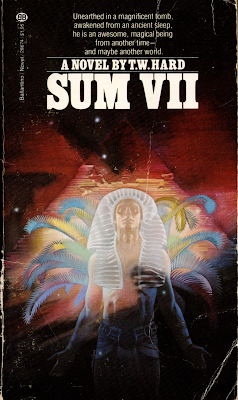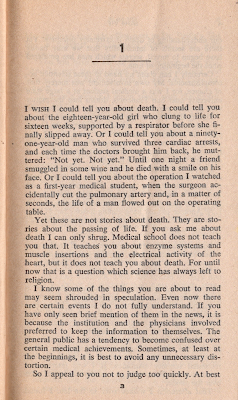Callow med student Bryan St. John tags along on a grave robbing expedition to Egypt, where a secret tomb is uncovered and a miraculously preserved body is whisked back to San Francisco for some outrageously unethical attempts at revival. This is 1979, not 1879, by the way, and spoilers abound, so beware!
Sum VII is unique, like no mummy ever seen before. His brains haven't been sucked out through his nose, nor have his other organs been removed and stored in jars per the standard Egyptian mummification process. In fact, his body is totally intact, and perfectly preserved ... as if he's in a state of suspended animation ...
Well, of course he is! And we know what's gonna happen, they're gonna wake him up and mayhem will ensue! To his credit T.W. Hard puts us through these predictable paces with a modicum of grace. The medical scenes having just enough techno thriller panache to carry us through the outre concept, and once ol' Sum VII is up and about Hard works well at portraying a person lost in time, savagely thrust into a world he never wanted. There's some technobabble gobbledygook that allows a computer to translate snippets of his ancient speech, but thankfully again Hard plays it just smart enough that it feels natural - it's all too little, too late for our modern day bunglers anyways, who find themselves one step behind the canny survivor. He's armed with intelligence, endurance, and mind powers that speak of something otherworldly. His mission? Go back to bed! St. John and the rest of the blinkered scientists eventually see the truth of his quest and oblige him. Farewell, traveler, you were ten times as three dimensional as any of your pursuers!
Sum VII sounds like a suitably dynastic name but author Hard plays cute with us - it's actually his specimen designation, standing for State University Museum, specimen 7 out of 7. It's a nice final wrinkle in this story of culture shock and future shock. Author Hard only put out a couple more titles, at least under this name, but he's hardly the worst writer to tackle paranormal fiction. Too bad.
 |
| A message from the ages |
For a cliched concept pulled off with acceptable ability, Sum VII earns two out of four ancient alien ankhs:
Ballantine Books, 1979
















